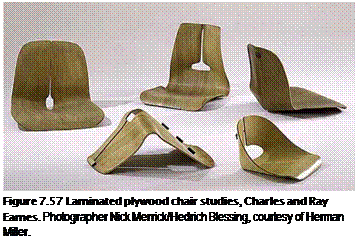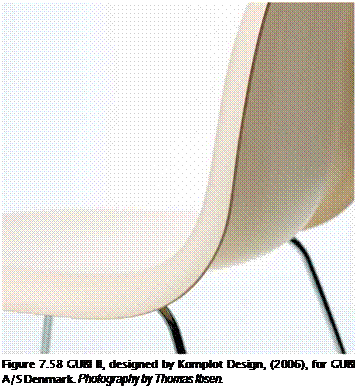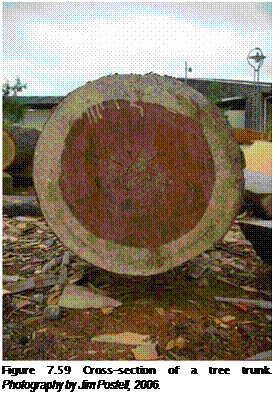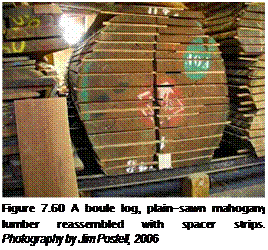 Wood
Wood
 Wood has been the standard material used to make furniture since recorded time. Today, the process of working with solid lumber (by hand) to mass-produced furniture is generally considered economically unfeasible. This reality has caused furniture designers and companies to consider veneers and composite panels, computer-controlled cutting tools, and automated processes of painting and finishing wooden furniture. Laminated veneers and formed plywood designs became popular in the late 1940s, a development attributed to the initial studies by Charles and Ray Eames (Figure 7.57). Since that time, many companies have developed furniture production and finishing technologies that utilize sophisticated machinery and digital processes of working with laminated and composite wood.
Wood has been the standard material used to make furniture since recorded time. Today, the process of working with solid lumber (by hand) to mass-produced furniture is generally considered economically unfeasible. This reality has caused furniture designers and companies to consider veneers and composite panels, computer-controlled cutting tools, and automated processes of painting and finishing wooden furniture. Laminated veneers and formed plywood designs became popular in the late 1940s, a development attributed to the initial studies by Charles and Ray Eames (Figure 7.57). Since that time, many companies have developed furniture production and finishing technologies that utilize sophisticated machinery and digital processes of working with laminated and composite wood.
GUBI, a furniture company in Copenhagen, has produced a line of chairs made by pressing presliced veneer sheets under pressure into graceful compound curves (Figure 7.58). The veneer sheets are fine-sliced before gluing and then formed into shape by a mold without cracking or buckling the veneers. The thin slices in the veneer fill with glue to set the veneer and are then sanded to look continuous. The chairs are well proportioned, comfortable, lightweight, and relatively inexpensive.
Despite the economic success that many designers and companies have had in making furniture that utilizes industrial processes, craftsmen and furniture designers continue to design and fabricate unique and limited-run studio furniture with lumber as the primary material. Therefore, knowledge of lumber and woodworking remains critically important for many designers and fabricators.
Furniture designers and furniture makers working with wood generally limit their selection to a few species from the several thousand available throughout the world. According to Ernest Joyce, author of The Encyclopedia of Furniture Making, there are over 43,000 different species of wood-forming plants, of which 30,000 are regarded as timber producers and about 10,000 species are commercially available.5
As mentioned earlier, humidity and moisture changes in the environment will cause wood to move (mostly perpendicular to the direction of its grain). Different woods respond to changes in moisture at different rates. Generally, hardwoods are more susceptible to dimensional change than softwoods, with beech, maple, chestnut, and white oak enormously susceptible to dimensional change. Walnut, poplar, and mahogany are some of the most stable.
The two main classifications of wood are softwoods and hardwoods. Softwoods are coniferous (cone-bearing), and though they will lose some needles, they usually remain green throughout the year. Hardwoods are deciduous trees that lose their leaves during the winter season. Generally, softwoods are physically soft, such as redwood, but some softwoods, such as spruce and yellow pine, can be very hard indeed. Hardwoods such as maple, birch, and ash are hard. Basswood, poplar, and balsa are "soft" hardwoods. Regardless of the general classification, what really matters is the specific material property of each species.
Wood Species
Individual wood species have particular characteristics, which cause certain species to be used for selective applications. Listed below are hardwoods and softwoods commonly used in making furniture, organized alphabetically:
■ Ash: White ash is a stable, straight-grain, and strong wood. It is exceptionally hard and shock resistant. Its heartwood is light tan, and its sapwood is creamy white. Ash is suitable for furniture and plywood veneer. It is readily available and moderate in its cost per board foot. Charles Renee Mackintosh used ebonized ash in his ladder-back upholstered chairs.
■ Beech: Its appearance is a medium brown wood with distinct open-cell grain. It is relatively easy to work and mill and takes finishes well.
■ Birch: Yellow birch is one of the prominent hardwoods. It is similar to maple, but has a bit darker color and is easier to work and mill. Its heartwood varies in color from medium to dark brown, while its sapwood is an off-white color.
■ Bubunga: This wood has a fine grain, is particularly dense, and finishes well.
■ Cherry: American black cherry is a reddish-brown hardwood that will darken, especially when exposed to direct sunlight. It is a stable closed-grain hardwood that may have an irregular face grain, with light sapwood and dark heartwood grain.
■ Hickory: This wood is pale brown in color, flexible, and strong.
■ Mahogany: Most mahogany woods are reddish brown in color. They are easy to mill and work. It is a stable wood. African mahogany is reddish brown; Honduran mahogany and Cuban mahogany are medium brown.
■ Maple: The sapwood of hard maple is particularly white, but its heartwood is brown. It is a dense hardwood with a closed grain. Maple lumber and veneer are available in bird’s eye, a particular and unique figure in the wood’s grain, the origin of which is not known.
■ Oak:
■ White oak is relatively medium brown in color and has an open grain, although a closed-cell structure. Its heartwood varies considerably in color from a light grayish tan to brown. It is hard, durable, and strong, making it an excellent hardwood in furniture.
■ Red oak is an open-cell grain and is relatively light in color. Uses include furniture, paneling, and casework.
■ Cork oak is a hardwood that grows throughout the Mediterranean. Its bark is used to make furniture and flooring.
■ Padauk: Padauk has hues of orange and red. It has a large open grain and is a particularly strong and stable hardwood. It receives stains and finishes well.
■ Pine: Ponderosa pine is light brown to light pink in color. It is a lightweight and relatively strong softwood. It is used in the interior core (as plies) for plywood.
■ 
 Purpleheart: It has a pronounced purple color that turns dark brown over time. It is a dense and strong hardwood that is particularly difficult to mill and work.
Purpleheart: It has a pronounced purple color that turns dark brown over time. It is a dense and strong hardwood that is particularly difficult to mill and work.
■ Teak: Brown in color, it is a strong, dimensionally stable, oily hardwood that is resistant to decay. It is originally from Burma. Its figure varies extensively and has limited uses for furniture and veneer work. It is an excellent wood for either indoor or outdoor applications.
■ Walnut: American black walnut is dark brown in color with light sapwood. It is a dense, stable hardwood with an open-grain structure. It is relatively easy to work and finishes well. Uses include furniture, paneling, and veneer work.
Different species reveal unique properties that include ray patterns, cellular structure, dimensional stability, color stability, workability, grain configuration, oil and silica content, modulus of elasticity, and coefficient of deflection. A cross-section of a tree trunk (Figure 7.59) reveals various layers from the bark to the center of its heartwood. The cambium layer is the layer just inside the bark and is made of a narrow ring of growth cells. The next layer inward is the sapwood, which distributes water and nutrients from the roots and is generally lighter in color than heartwood. Heartwood is the most generally desirable part of trees (darkened by extractives deposited over time) except for the maples, birch, and ash most desired for their lighter sapwood. The pith is the center of the tree and is impossible to use for furniture-making purposes because it is much too small. The outer protective layer of a tree is the bark. In birch and Spanish oak trees, bark is a useful material. Cork is the subcutaneous bark of the cork oak, Quercus suber, which grows in the Mediterranean region. Cork is light, porous, easily compressed, and elastic. It is a natural, closed-cell wood product and is waterproof. Compressing granulated cork under heat makes corkboard.
While some lumber is air dried, most is sent to a kiln. Most lumber mills use kilns to dry wood at a temperature between 110 and 180 degrees Fahrenheit. The desirable moisture content of dried lumber for interior use usually ranges from 6 to 12 percent, depending upon its use and intended location. Kiln-drying methods also usually kill most diseases or insects that might be present in the wood. Furniture used in controlled environments will have a moisture content close to 6 percent. It is ideal to work with wood and make all the joinery while the moisture content is compatible with its surroundings. Generally, wood will accept finishes better in drier conditions.
The direction of the grain in lumber depends on the tree’s growth over time as well as the manner in which it was cut at the lumber mill. Plain sawn, quarter sawn, and rift sawn are three ways to cut lumber from the trunk of a tree.
The most economical way of securing lumber from a tree is to plain saw the tree by repeatedly cutting the log in a straight line from top to bottom (Figure 7.60). This process will produce a majority of plain-sawn lumber, but some of the lumber will be rift and quarter
sawn as well. A "cathedral" grain pattern results from cutting straight down through the "stack" of the tree’s growth rings. Plain-sawn cutting produces boards that may cup or warp over time because of the inherent stresses in the lumber. Quarter sawing results in the straightest face grain possible and is also much more stable. This process also yields less lumber and is therefore more expensive.
Quarter-sawn logs are cut into four equal parts along the length of the log. Each quarter is then positioned on the saw and ripped at 90 degrees. When the resultant cut lumber is between 30 and 45 degrees to the tangent of the growth rings, the lumber is called rift cut. Both rift – and quarter-sawn lumber are equally strong. Quarter-sawn lumber is more stable than plain-sawn lumber and is also more uniform in its face grain appearance.
Lumber expands or contracts perpendicularly to the axis of the grain; consequently, the designer must consider movement due to moisture variations. Joints such as the mortise and tenon, lap, finger, and dovetail have evolved over time to join pieces of wood together. Maximizing the surface of the joint in order to maximize the surface within the joint is important to its strength and long-term durability. Dowel pins, screws, and adhesives are options to consider in mechanically attaching wood together. Care must be taken with simple metal screw-to-wood connections, because over time, screws will loosen from the wood. It is always best to use metal-to-metal connections such as screws and threaded metal inserts.



